In 2016, I found myself managing three organizations. My family real estate business, a fledgling school, and a startup.
Around that time I also became a dad.
I woke up everyday pulled in different directions, not knowing where to focus.
I couldn’t sustain working this way, but at the same time, I loved my work and didn’t want to give any of it up.
GTD was still working wonders for me individually. It gave me a way to experience stress-free productivity, and I was achieving Mind Like Water.
But I wasn’t getting the same experience when working on common goals with my team. I would find myself:
- Running behind them with my Waiting-For list, asking for updates
- Getting bogged down with small details, that was not worth my time
- Being involved with too many painfully long meetings
I began to search for ways to give my team more autonomy, but in a way that would protect the purpose of the organization.
It’s around that time I came across Holacracy. I was particularly excited to try it out because I learned David Allen, founder of GTD, was practicing it in his own organization.
This is what David says in the foreword of the book, Holacracy:
“When I heard Brian speak about changing a fundamental operating system to achieve the organizational equivalent of “Mind Like Water” (a metaphor I use for an individual clarified state, achieved with GTD), I knew this was a frontier worth exploring.
Once you have tasted the increased clarity generated by the meeting and communication formats, it’s hard to dismiss the system.”
I journeyed to Holacracy, and adopted it to various extents in all three of my organizations.
Holacracy gave me a way to extend the practice & benefits of GTD across my organization. I have now:
- Real-time clarity on who’s accountable for what. This avoids confusion.
- A more autonomous team, that take ownership of their projects,
- A common place to track projects, so everyone knows the status.
- Effective meeting practices, that help to quickly raise issues and find pathways to address them.
In this post I’m going to share with you how you can use the Holacracy practice, and its supporting software Glassfrog, to achieve Mind Like Water for your organization.
What is Holacracy?
By now you might be wondering, “What the heck is Holacracy?”
In a nutshell, Holacracy is a set of rules on how to structure your organization. Just like a game has rules on how to play, Holacracy gives you rules on how to structure your organization.
Note, these rules don’t tell you how to “run” your organization, like hiring, firing, compensation, etc.
They are rules on how the work of the organization is clarified, along with meeting practices to create alignment.
Glassfrog is the software to support your Holacracy Practice. In this post, I’m going to show you how I use it to:
- Clarify the structure of my organization
- Record metrics, checklists & projects
- Run Tactical Meetings
So let’s explore how you can extend the practice of GTD across your team.
1. Start with the Team’s Purpose
Do you remember this model from the GTD Methodology?
It’s called the Horizons of Focus:
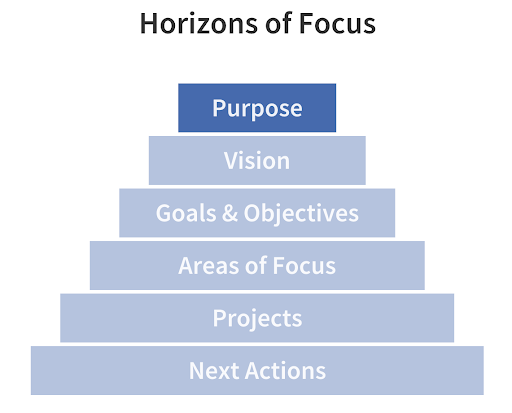
By clarifying your commitments across each of the Horizons, you have better access to your intuition to prioritize your work.
Just like an individual has a purpose, so does a team. A team is defined as a group of people coming to work together for a common purpose.
Imagine a team without a purpose. What’s the point of working together? Without a purpose is there even a need for it to exist?
So what is your team’s purpose? And is it clear to everyone on the team what the purpose is?
Once your team’s purpose is clarified, it becomes the guiding force that will help you make decisions, prioritize what is important & increase your chances of reaching your goals.
You can break down the purpose into a 5 year vision, and 2 to 3 year goals.
In Calm Achiever, we do clarify the purpose, however we hold 5 year plans, 2 to 3 year goals lightly.
Given how fast the world is changing, these long term goals usually reveal themselves once we focus on the short term commitments.
2. Empower Team Through Transparency in Accountabilities
In GTD, “Areas of Focus” is where you clarify your ongoing commitments. These could be around health, finances, relationships.
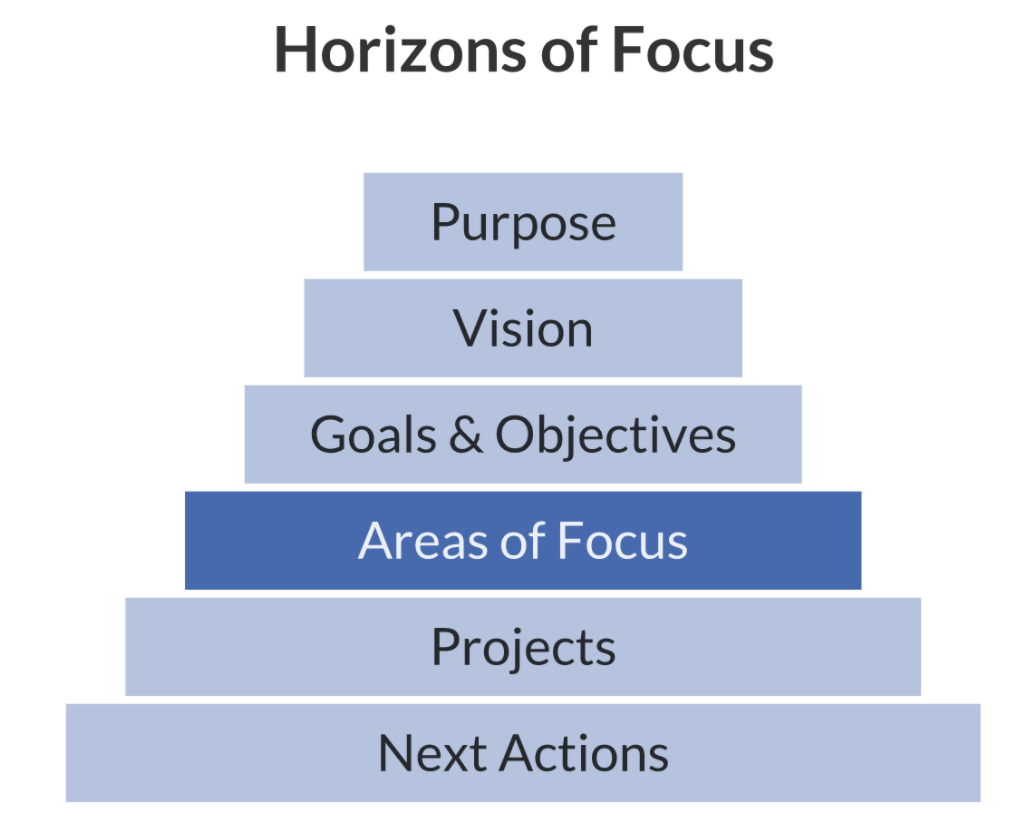
But here’s the problem: Does anyone actually refer to their job description after they’re hired?
Hardly.
People don’t refer to them because they don’t reflect reality. While the work shifts and adjusts to meet demands, the job description remains the same. And when accountabilities are not clear it creates confusion on who should handle what.
In Calm Achiever, instead of job descriptions, we break down the work into smaller roles that people fill.
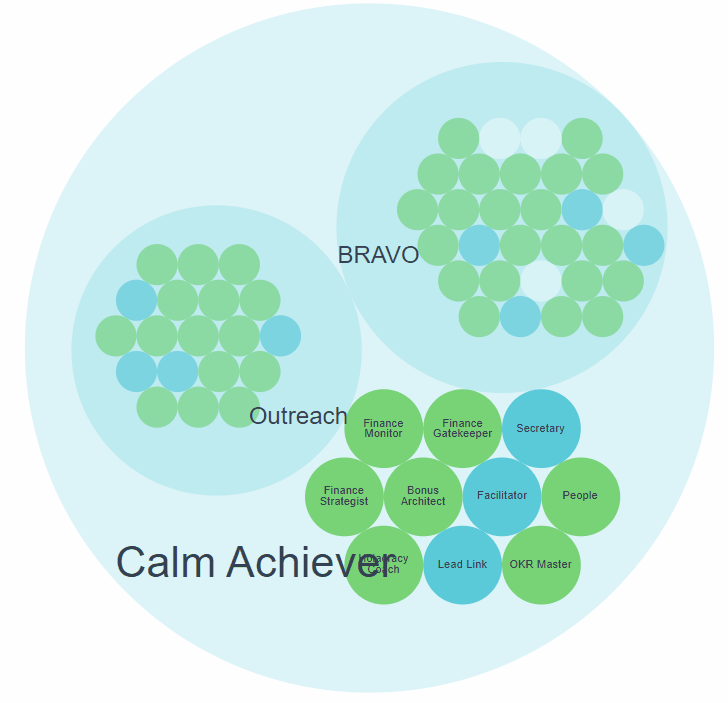
Each role has a clear purpose & accountabilities.
People with the right talent and interest will fill the relevant roles. One person can fill multiple roles.
Here’s an example of a role I fill:
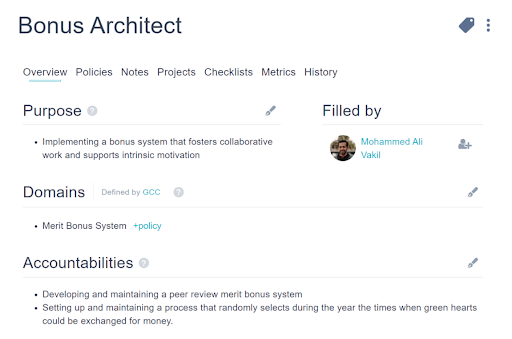
Notice how the work of my role “Bonus Architect” is broken down into its:
- Purpose:
The reason the role exists - Domain:
The assets the role is controlling - Accountabilities:
Ongoing activities the organization can expect
Currently, I fill these roles in Calm Achiever
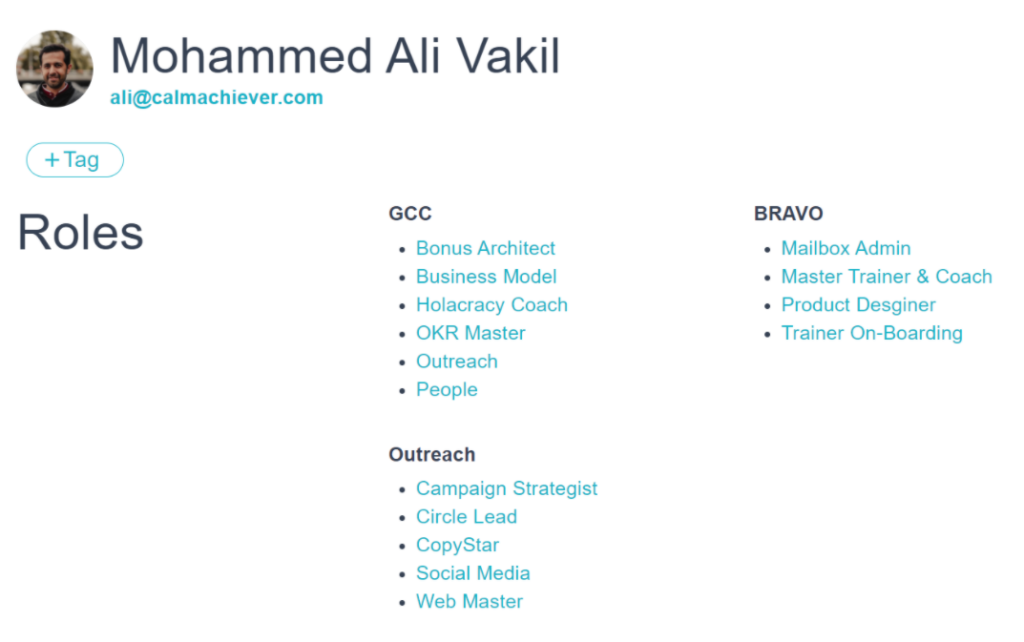
These roles are not static, they evolve over time. There’s a process to iterate the accountabilities of these roles as things change.
Unlike job descriptions that are often outdated and irrelevant to day-to-day work, in Holacracy people can fill multiple roles with clear & regularly updated accountabilities so that everyone knows what is expected from each role.
Key differences between positions in a management hierarchy and a role based structure:
| Positions in a Management Hierarchy | Role-based Structure |
| Positions are static and change only when there’s a re-org | Roles are dynamic and easier to change. |
| Positions are fused with the individual filling it | Roles allow easier movement between them. |
| Positions descriptions are often not transparent to all members of the organization. | Roles create transparency on who’s accountable for what. |
I’ve found a role-based structure much easier to update and clarify, at any point in time, who’s accountable for the work.
3. Create Alignment with an Effective Meeting Structure
Here are some common challenges I hear from GTD Practitioners working in teams:
- My waiting-for list is growing so long. I end up spending time running behind people to get updates. It’s like I’ve become their secretary.
- I don’t have clarity on who’s working on what project.
- During meetings I don’t see people capturing their actions and projects. I don’t have confidence they’ll get the work done.
I can totally relate to this. And I see why it happens.
While Projects and Next Actions are owned by individuals, when working in teams they often involve other people.
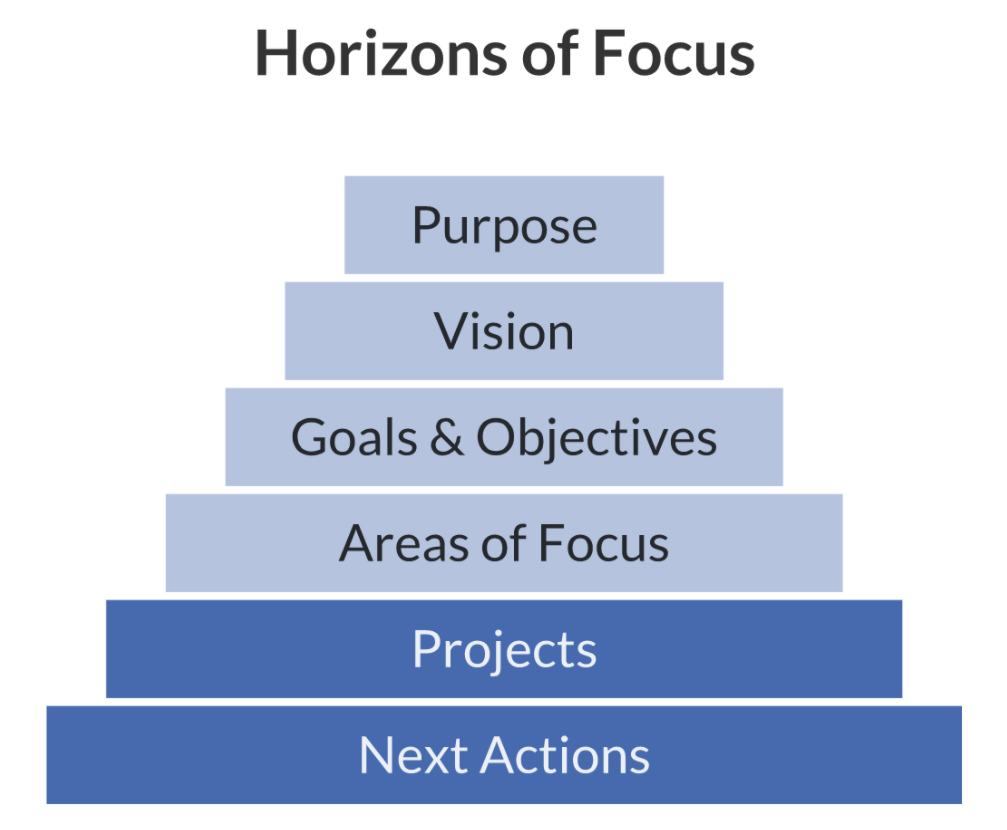
I use the Holacracy Tactical Meeting process to get alignment on Projects & Next Actions. The alignment happens through the meetings.
Wait… what… meetings? Oh no… not another meeting. Aren’t meetings a waste of time?
Trust me, I get it. Before I implemented Holacracy in my organization, I used to hate meetings.
Here’s what would frustrate me:
- I’d find people raising issues, and expecting the boss to solve their problems (while they’re more than capable of solving it themselves).
- Meetings drag on long with the extroverts talking most of the time, endlessly discussing issues.
- When someone would raise an issue, other people would jump in to hijack the agenda to solve their own issues.
- There would be little space for the quiet introverts to share their insights.
- End of the meeting, it wouldn’t be clear who has to take what action.
However, the Holacracy Tactical meeting process has been structured exactly to avoid the above.
Here’s what makes it work. In every meeting there are two key roles:
- A Facilitator who Facilitates the meeting, keeps to time, holds space to process one agenda at a time.
- A Secretary who organizes the meeting, and captures any actions and projects emerging from an agenda item.
This helps to keep the meeting:
- Action-oriented with concrete outputs.
- Able to give every team member the opportunity to get what they need.
- Moving at a fast pace, with agendas built on the fly.
Let me show you how it works. The meeting is in 2 parts.
Part 1 – The Preamble
The steps of the preamble:
- Check-in
- Checklists Review
- Metrics Review
- Projects Review
There’s no discussion at this stage. Only reviewing key information relevant to the team. This surfaces useful information for team members to know, and can trigger Agenda items to discuss.
Part 2 – Building the Agenda and Processing Each Agenda Item
This part starts by building the agenda of issues to process. This is not so different from doing a GTD mindsweep.
Unlike typical meetings where people look to the leader to solve their problems, over here the facilitator will hold space to process each agenda item by asking the Agenda holder “What do you need?” and present 4 options to choose from.
They can:
- Request for A Next Action or Project from a role
- Ask Information from the team
- Share Information
- Request to set an ongoing expectation (like adding a new accountability)
Here’s the thing, any request that you can think of can be slotted in one of these four.
There’s a parallel to GTD here. Every item that you capture, can be clarified in one of six buckets:
- If actionable: Do it, Delegate or Defer it.
- If not actionable: Trash, Incubate or Reference
Similarly, in the Holacracy Tactical meeting, every agenda item can be processed using one of the four options above. Knowing this upfront encourages the team to clear their mind of the concerns they have.
We use Glassfrog during the meeting to review the key numbers, and capture the next actions & projects. At the end of the meeting, the outputs are emailed to all the team members.
Here’s what the email looks like:

We schedule these meetings every fortnight and usually take us 45 to 60 mins. We get transparency on the metrics, and status updates on projects. Everyone gets a chance to process their issues. At the end, we have clear actionable outputs assigned to the relevant roles.
Experience a Simulation of an Organization Practicing Holacracy
It’s one thing to read about Holacracy, and another thing to experience it.
If you’d like to see how you can get the benefits of GTD across your team, I invite you to join a Live Workshop where you’ll get hands-on experience on what it’s like running an organization using Holacracy.
What you’ll experience?
- How to structure your team into roles to give clarity, and enable autonomy
- Lightning-quick, action-focused Tactical Meetings
- Steps you can take to implement Holacracy in your organization
I believe our work should be an expression of our most creative selves. I work with business owners and their teams to achieve stress-free productivity.

